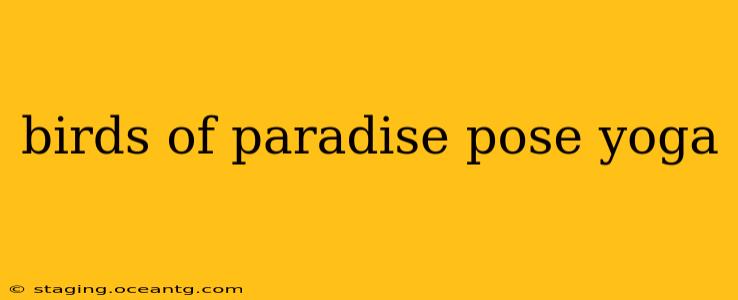The Birds of Paradise pose, or Natarajasana, is a challenging yet rewarding yoga posture that builds strength, balance, and flexibility. This advanced standing asana requires dedication and practice to master, but the benefits are well worth the effort. This guide will delve into the intricacies of Birds of Paradise, addressing common questions and offering tips for safe and effective practice.
What are the benefits of Birds of Paradise Pose?
The Birds of Paradise pose offers a multitude of benefits, impacting both physical and mental well-being. Physically, it strengthens the legs and ankles, improves hip flexibility, stretches the shoulders and chest, and enhances balance and coordination. Mentally, it cultivates focus and concentration, promoting a sense of calm and stability. Regular practice can also improve posture and increase body awareness.
How do you do Birds of Paradise Pose?
Mastering Birds of Paradise requires a gradual approach. Beginners should focus on building foundational strength and flexibility through preparatory poses like Warrior III and Tree Pose. The pose itself involves standing on one leg, bending the other leg behind you and grasping the foot. The torso is bent forward, creating a graceful, bird-like shape. Detailed instructions, including modifications for different skill levels, can be found in numerous yoga resources and online tutorials. Always prioritize proper alignment to avoid injury.
Is Birds of Paradise Pose good for beginners?
While the pose is visually striking, it's not suitable for complete beginners. It demands a significant level of balance, strength, and flexibility in the hips, hamstrings, and shoulders. Attempting the pose without proper preparation could lead to injury. Beginners should focus on mastering preparatory poses before attempting Birds of Paradise. A qualified yoga instructor can provide personalized guidance and modifications to ensure safety and progress.
What are some modifications for Birds of Paradise Pose?
Several modifications can make Birds of Paradise more accessible to those with limited flexibility or balance. Using a yoga strap to hold the foot can alleviate strain on the hamstring and improve access to the pose. Practicing near a wall for support can enhance stability and confidence. Focusing on gradual progression and listening to your body are crucial for avoiding injury.
What are the common mistakes to avoid in Birds of Paradise Pose?
Common mistakes in Birds of Paradise include hunching the shoulders, over-arching the back, collapsing the chest, and neglecting to engage the core muscles. These mistakes can compromise alignment, reduce the benefits of the pose, and increase the risk of injury. Paying close attention to proper alignment and engaging the core are vital for safe and effective practice.
How can I improve my balance for Birds of Paradise Pose?
Improving balance requires consistent practice of balancing poses like Tree Pose, Warrior III, and Half Moon Pose. Strengthening the core muscles is also crucial for balance. Practicing yoga poses regularly, along with activities such as Tai Chi or Pilates, can significantly enhance balance and stability.
Is Birds of Paradise Pose a good warm-up or cool-down pose?
Birds of Paradise is not a suitable warm-up or cool-down pose. Its complexity demands a well-prepared body. It should be practiced after sufficient warming up with other poses and only attempted after building strength and flexibility.
What muscles does Birds of Paradise Pose stretch and strengthen?
Birds of Paradise primarily stretches the hamstrings, hip flexors, groin, shoulders, and chest. Simultaneously, it strengthens the legs, ankles, core, and back muscles. This makes it a well-rounded pose for building both flexibility and strength.
By understanding the intricacies of Birds of Paradise, and gradually working towards mastering the pose with proper preparation and mindful practice, you can reap its numerous physical and mental benefits. Remember, consistency and patience are key. Always listen to your body and consult a qualified yoga instructor for personalized guidance.
